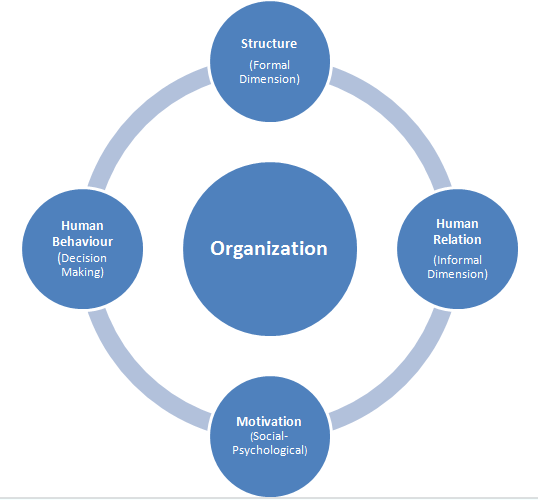
Organization is a group of people with a particular purpose. Urwick and Gullick identified principles of administration applicable to all organization.
Different Approaches of Organization:

Structure of Organization
- They mostly dealt with the technical aspects of formal organization.
- They formulated ‘Universal Principle of Organization’, popularly called as ‘Classical Theory of Organization’ or ‘Administrative Management Theory’.
- They attached more importance to the structure of the organization than the people.
Bases of Organization: (or Principles)
- Division of work: (Departmentalization)
- According to Gullick, work division is the foundation of any organization.
- Necessary because men differ in nature, capacity and skill.
- Assigning functions based on homogeneity
- Gullick’s ‘4P’ bases of organization:
- Purpose
- Process
- Person dealt with
- Place they work
- In sub-dividing the work, the more relevant factor(s) might be considered mainly.
- Coordination: (through hierarchy)
- Sub-division of work is inescapable, therefore coordination becomes mandatory.
- Coordination can be achieved by:
- Allotting them to people appropriately placed in the structure.
- Motivation so that each works voluntarily fits his task into the system.
- It does not develop by accident but must be won by intelligent, vigorous, persistent and organized efforts.
- Unity of command: (single orders)
- They believed that well managed administrative units are headed by single administrators.
- Orders from more than one supervisors and workmen will be confused, inefficient and irresponsible.
- They were against boards and commissions, etc.
- Line and staff: (subordinates)
- Officials in their everyday work do not have time to read, think and meet their subordinates.
- Staff relives the top executives from burdensome details of administration.
- Span of control: (limited supervision)
- A supervisor can supervise only a limited number of works directly.
- The chief executive can deal with only a few intermediate subordinates.
- They supported the concept of a narrow span of control.
- Decentralization: the transfer of authority from central to local Government
- Delegation: the assignment of any authority to another person (normally from a manager to a subordinate) to carry out specific activities
Duties of an Administrator: POSDCORB
- Planning
- Organizing (structure, division, coordination)
- Staffing (training, condition)
- Directing (orders)
- Coordinating
- Reporting
- Budgeting (fiscal planning, accounting)
Seven-S Model of Organization: by McKinsey
Often used as an organizational analysis tool to assess and monitor changes in the internal situation of an organization.
It is based on the theory that, for an organization to perform well, the 7 elements need to be aligned and mutually reinforcing. The 7 elements may be categorized as Hard and Soft.
Hard Elements:
- Strategy: purpose of business
- Structure: division, coordination
- Systems: procedure of reward and resource allocation
Soft Elements:
- Shared values
- Skills
- Staff
- Style: behaviour pattern of key manpower
Significance of Organizational Theory:
- Identification of Organization as distinct function to be studied and practiced.
- Clear thinking about authority, delegation, etc.
- Rationalizing and stimulating more work and performance.
- Help in further investigation of an organisation.
Criticism of Organizational Theory:
- They displayed a pro-management bias in their theories; they were concerned with the problems of management only.
- They fail to explain the dynamics of organizational behaviour and looks the individual in isolation.
- They do not take note of non-economic activities.

 Home
Home Syllabus
Syllabus Contact Us
Contact Us




